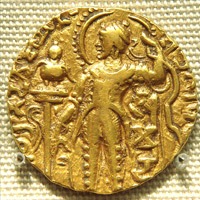Samudragupta, was the forth ruler of the Gupta Empire. Samudragupta ascended the throne in 335 AD Due to his military conquests and annexations, he is considered to be a great military genius India has ever produced; Vincent Smith called him Napoleon of India. His name is taken to be a title acquired by his conquests as Samudra means `oceans’. He is believed to have been his father’s chosen successor even though he had several older brothers. It is, therefore, believed that after the death of Chandragupta I, there was a struggle for succession in which Samudragupta prevailed.
Interestingly, the king Samudragupta referred to his maternal lineage (proudly calling himself Lichchhavidauhitra meaning son of Lichhhavi) instead of the more common reference to paternal lineage. After ascending the throne Samudra Gupta started an era of military conquests and he was able to conquer Ahichchhatra, Nagasena, south till Bay of Bengal, Madhya Pradesh, Orissa coast, Ganjam, Vishakapatnam, Godavari, Krishna and Nellore districts. He might have reached as far as Kancheepuram. He did not attempt to maintain his direct control over the territories as after capturing his enemies he reinstated them as tributary kings. The main source of Samudragupta’s history is an inscription engraved on one of the stone pillars set up by Ashoka in Kausambi (present day Allahabad) and the eight types of coins made of pure gold. The inscription provides the details of his conquests while on the other side of the coins are details about his patronage of art and learning.
Samudragupta was a patron of learning, a celebrated poet and a musician. Several coins depict him playing on the lyre. Samudragupta had several sons. Samudragupta died in AD 380, and was succeeded by his sons Ramagupta and Chandragupta.
This article was last updated on Monday, Jan 03, 2005






